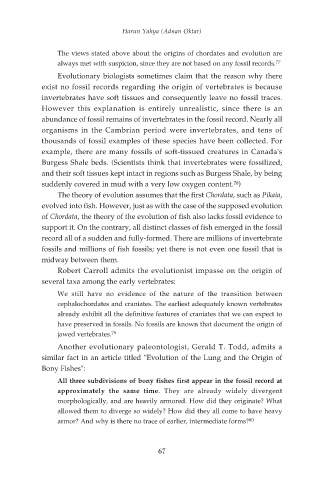Page 69 - Darwinism Refuted
P. 69
Harun Yahya (Adnan Oktar)
The views stated above about the origins of chordates and evolution are
always met with suspicion, since they are not based on any fossil records. 77
Evolutionary biologists sometimes claim that the reason why there
exist no fossil records regarding the origin of vertebrates is because
invertebrates have soft tissues and consequently leave no fossil traces.
However this explanation is entirely unrealistic, since there is an
abundance of fossil remains of invertebrates in the fossil record. Nearly all
organisms in the Cambrian period were invertebrates, and tens of
thousands of fossil examples of these species have been collected. For
example, there are many fossils of soft-tissued creatures in Canada's
Burgess Shale beds. (Scientists think that invertebrates were fossilized,
and their soft tissues kept intact in regions such as Burgess Shale, by being
suddenly covered in mud with a very low oxygen content. )
78
The theory of evolution assumes that the first Chordata, such as Pikaia,
evolved into fish. However, just as with the case of the supposed evolution
of Chordata, the theory of the evolution of fish also lacks fossil evidence to
support it. On the contrary, all distinct classes of fish emerged in the fossil
record all of a sudden and fully-formed. There are millions of invertebrate
fossils and millions of fish fossils; yet there is not even one fossil that is
midway between them.
Robert Carroll admits the evolutionist impasse on the origin of
several taxa among the early vertebrates:
We still have no evidence of the nature of the transition between
cephalochordates and craniates. The earliest adequately known vertebrates
already exhibit all the definitive features of craniates that we can expect to
have preserved in fossils. No fossils are known that document the origin of
jawed vertebrates. 79
Another evolutionary paleontologist, Gerald T. Todd, admits a
similar fact in an article titled "Evolution of the Lung and the Origin of
Bony Fishes":
All three subdivisions of bony fishes first appear in the fossil record at
approximately the same time. They are already widely divergent
morphologically, and are heavily armored. How did they originate? What
allowed them to diverge so widely? How did they all come to have heavy
armor? And why is there no trace of earlier, intermediate forms? 80
67

